On September 10, for the second of two nights at the Microsoft Theater in downtown Los Angeles, cable television, broadcast television, and new media craftspeople gathered for the Creative Arts Emmy Awards, with largely new categories following the first evening.
First, a succession of musical composers traversed the red carpet. David Buckley, composer for The Good Fighter, explained writing musical themes and full scores. “We could have a bit of real estate in a main title rather than the seven seconds,” he said of his allocated time for creating the theme music. “I think it was a-minute-and-twelve seconds. So the process was with the graphics department: we were both in a stalemate about who was going to go first. Are they going to put some pictures together, or am I going to put music together? It was a back and forth.”
OJ: Made in America’s composer, Gary Lionelli, talked about his artistic inhibitions so as to avoid over-sensationalizing or trivializing the weighty material with his music. “I tried to take a thematic approach and comment on the overall tragedy of the situation and the deaths of Nicole Brown Simpson and Ron Goldman,” he said, “and how a former hero got to the point where he’s driving down the 5 freeway with a gun to his head in a Bronco. How did that happen?”
Focusing on the subtext of the full work, Lionelli was able to view extensive footage from the show before embarking on his composition of the score, for which he was required to write seven-and-a-half hours of music. “It was a daunting idea,” he said. “Initially they gave me three-and-a-half months. It was impossible, but eventually they gave us six months; you do one piece of music at a time and try not to focus on the whole madness of it all.”
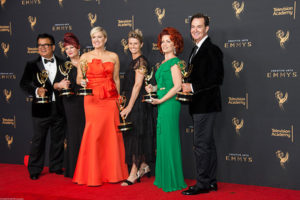
Photo by: Amber Connelly
For his work on House of Cards, composer Jeff Beal won the Emmy for best music in a dramatic show and spoke of working for Netflix. “How they treat creatives is different in the sense that they leave you alone more than a lot of networks,” he detailed. “If you give real artists that leash, they will often take it and make something great. I think everyone felt that sense of freedom, but also a responsibility to really do something meaningful. I’m so invested in the creativity of the show and the voice of the music as a character.”
Beal has conducted his music from House of Cards at the Kennedy Center and in Jerusalem, Israel. “I curated clips from the first four seasons,” he said, “cut them into montages representing a character or theme, and it’s really fun to bring it to a concert hall that way.”
Jeremy Turner was also nominated for his musical compositions in Five Came Back, in which the contributions of five prominent Hollywood film directors during World War II are profiled. The series stars titans of filmmaking including Steven Spielberg, Francis Ford Coppola, and Guillermo Del Toro. “They give you a tremendous amount of freedom,” Turner said. “They’re strong allies of artists and producers, and they give you a lot of rope to work with. I had to lock myself in a cave and write music at a rapid pace—keep the level high. The theme was the only thing I didn’t do. It ended up being 140 minutes of orchestral score written in five weeks. It was intense.”
It is the rare film which becomes a successfully developed television series, to say nothing of one regarded as highly as the initial movie which spawned it. In the case of Fargo, both are true, leading to numerous Emmy nominations. Taking Fargo from movie to TV show was the challenge undertaken by executive producer, writer, and showrunner Noah Hawley. Among Hawley’s key collaborators was musical composer Jeff Russo, who won his first Emmy for Fargo this year, after being nominated the first two seasons. “When Noah first had the idea of doing Fargo, people though it was a bad idea,” Russo confessed, “and he was able to pull off a creative coup to tell the story, but tell it in that tone. I think that’s what did it; we stayed true to the name Fargo. We stayed true to the way that story is told but created a whole new world. I get to do something different every season —we need new themes, pieces, and characters. That posed an interesting creative conundrum for me, but I dive right in and start writing every year.”
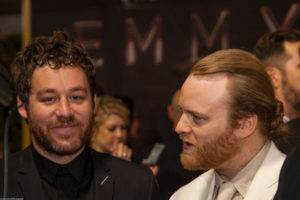
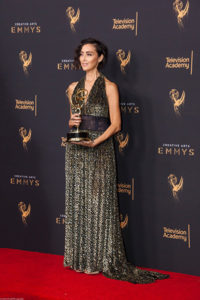
Perhaps the youngest Emmy winners, Michael Stein and Kyle Dixon were recognized for their music on Stranger Things. “It’s great to be a part of the best show on TV,” said Stein. “No one says, ‘No.’ We try to push what we think they’ll let us do.”
Dixon commented on their youthful entry into the arena of awards shows with Stranger Things. “We haven’t done anything prior to this, and we lucked into something that was doing so well,” he said. “Hate to say it’s a dream come true, but we’ve been wanting to do this for a while, and it finally happened.”
Casting director Carmen Cuba, an Emmy winner for her work on Stranger Things, spoke about her global search to find juvenile lead actors. “A lot of times, when kids are the lead of a film, you get six months for a worldwide search; we had about 10-12 weeks,” she said. “And, for TV, you need the families to agree to a six-year commitment; for a movie, you have three months. One of our kids is from Canada, one is British, and two are from New York.”
Cuba noted that final casting choices are done largely on instinct. “You can’t really quantify it; it’s just a feeling,” she revealed. “But when you’ve only seen them on tape and not in person, you have to dig a little further. Mille Brown—we saw her tape, and we gave her more material and thought she was amazing. Then we Skyped her. She was just so well balanced, dressing up and putting on accents.”
Longtime visual effects cinematographer Dave Stump walked the carpet, being nominated for best visual effects for American Gods. “There’s a great mixture of visual effects techniques,” he said. “I still do miniatures; I still do models; sometimes even motion control. There were a lot of digital effects, but there were a lot of practical effects, including live-action compositing. Our keynote visual effect is our ‘godflesh’ effect.”
Multiple Emmy Award-winner Eryn Krueger Mekash, makeup designer for American Horror Story, spoke of her symbiotic relationship with series creator Ryan Murphy, with whom she has worked for 14 years. “It starts with Ryan and his concept,” she affirmed. “Dave Anderson and I work together to fulfill that, and we start presenting ideas and go from there. We constantly reinvent things. The ‘Addiction Demon’ from [American Horror Story—Hotel] was four-and-a-half hours, using three makeup artists. Alex [Alexander Ward] was without sight, sound or bathroom facilities and would stay like that for 15 hours.”
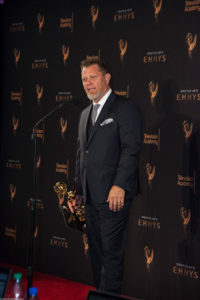
Another Emmy Award-winning makeup artist, Christian Tinsley, spoke of his technical achievements, utilized for HBO’s Westworld, but which he first created for the feature film The Passion of the Christ. “The prosthetic transfer—everybody is using it on every film that is being nominated,” he noted. “It’s been integrated into part of the systems in which makeup is being done today. Everything is created by necessity.”
For her work on Hulu’s The Handmaid’s Tale, production designer Julie Berghoff won the Emmy for Outstanding Production Design for a Narrative Contemporary or Fantasy Program. “I had to look for locations where I could put Puritan costumes but still appear to be modern day,” she stated. “We only had eight weeks to prep, but we found the primary house after four. My team were really up against the wall because we were looking for a house that had character that was Victorian or similar, and it was in Toronto.”
For the interior set, Berghoff constructed most of the main house, a spiral staircase, bedroom, a kitchen, and office. “It ended up taking the entire stage floor,” she related. “We have a 20-person art department and two graphic designers. Every label in that grocery store was custom made without a label on it; imagine creating a world with no words. We had carpenters and painters working every night seven-days-a-week.”
Berghoff’s next television project concerns the short stories of Philip K. Dick, including five set in London and five in Chicago. Called Electric Dreams, the show will run on Amazon in January of 2018.
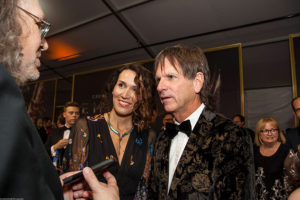
Lastly, the first season of HBO’s Westworld generated interest in a Michael Crichton property that had been dormant for 40 years. The result has been a horde of Emmy nominations, including one for cinematographer Paul Cameron. “I was fortunate enough to do the pilot,” he said. “What makes it unique is the people involved. It was a great story, plus working with creator Jonathan Nolan and the production designer, Nathan Crowley. It was a really great conceptual period, and we realized we could take it pretty far.”
Filmed in Melody Ranch in Santa Clarita, California, Big Sky Ranch around Simi Valley, and in the picturesque broad landscapes of Utah, Westworld might obtain its unique look from the fact that Cameron shot it on 35mm film. “I was so nervous to ask if we could do it,” Cameron recalled, “and five minutes into the meeting, we already agreed we would shoot it on film. There’s a certain reverence, a certain magic about shooting on film.”





